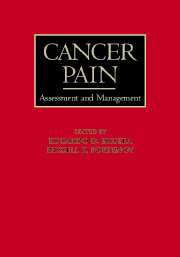Book contents
- Frontmatter
- Contents
- List of contributors
- Preface
- SECTION I MECHANISMS AND EPIDEMIOLOGY
- SECTION II ASSESSMENT AND SYNDROMES
- SECTION III PHARMACOLOGICAL TREATMENT
- 7 Pharmacology of analgesia: basic principles
- 8 Pharmacology of opioid analgesia: clinical principles
- 9 Opioid side effects and management
- 10 Nonopioid analgesics
- 11 Adjuvant analgesic drugs
- SECTION IV NONPHARMACOLOGICAL APPROACHES
- SECTION V THE ROLE OF ANTINEOPLASTIC THERAPIES IN PAIN CONTROL
- SECTION VI PAIN IN SPECIAL POPULATIONS
- SECTION VII DIFFICULT PAIN PROBLEMS
- SECTION VIII SPECIAL TOPICS
- Index
10 - Nonopioid analgesics
from SECTION III - PHARMACOLOGICAL TREATMENT
Published online by Cambridge University Press: 08 October 2009
- Frontmatter
- Contents
- List of contributors
- Preface
- SECTION I MECHANISMS AND EPIDEMIOLOGY
- SECTION II ASSESSMENT AND SYNDROMES
- SECTION III PHARMACOLOGICAL TREATMENT
- 7 Pharmacology of analgesia: basic principles
- 8 Pharmacology of opioid analgesia: clinical principles
- 9 Opioid side effects and management
- 10 Nonopioid analgesics
- 11 Adjuvant analgesic drugs
- SECTION IV NONPHARMACOLOGICAL APPROACHES
- SECTION V THE ROLE OF ANTINEOPLASTIC THERAPIES IN PAIN CONTROL
- SECTION VI PAIN IN SPECIAL POPULATIONS
- SECTION VII DIFFICULT PAIN PROBLEMS
- SECTION VIII SPECIAL TOPICS
- Index
Summary
History of antipyretic analgesics
Fever was the cardinal symptom of disease in the hippocratic medicine. It was assumed to result from an imbalance of body fluids. Therefore, it was the aim of Hippocratic medicine to correct the balances of fluids by either bloodletting, purgation, sweating, or, above all, administering drugs that normalized body temperature. The leading compound in the 18th and 19th centuries for that purpose was quinine, which became scarce in continental Europe during and after the Napoleonic wars as a result of the continental blockade. The emerging synthetic chemistry and drug industry concentrated on producing chemical analogs of quinine and its derivative quinoline as substitutes of the natural products. Moreover, pharmaceutical chemists attempted to isolate substances with similar antipyretic activity from other plants. The results of these efforts were the three prototypes of antipyretic non-opioid analgesic drugs still in use. On the basis of the work of Piria in Italy, Kolbe synthesized salicylic acid as an antipyretic agent in 1859. In 1897, salicylic acid was acetylated by Hoffmann to form aspirin. In 1882, Knorr and Filehne in Erlangen synthesized and tested the non-acidic agent phenazone (antipyrine), which proved to be effective in the clinic. Phenazone was the first pure synthetic drug worldwide. Its introduction as an antipyretic and later as an analgesic led to the discovery of various phenazone derivatives that are still used every year in ton quantities. Almost at the same time, Cahn and Hepp in Strasbourg found that acetanilide may also reduce fever. Acetanilide was introduced as antifebrin, but was later replaced by phenacetin and finally by paracetamol (acetaminophen), which is believed to be safer.
- Type
- Chapter
- Information
- Cancer PainAssessment and Management, pp. 171 - 187Publisher: Cambridge University PressPrint publication year: 2003



